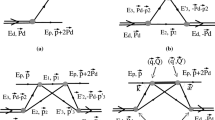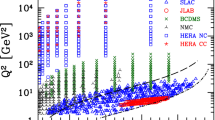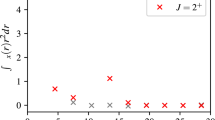Abstract
Inelastic electron—nucleon scattering is discussed. The theoretical ideas are compared with recent experimental data on proton and deuteron target. Particular attention is payed to the duality aspect of the data.
Резюме
Рассмотрено неупругое рассеяние электронов на нуклонах. Теоретические выводы сравниваются с новыми экспериментальными данными, полученными на протонной и электронной мишенях. В частностн, обращено внимание на аспект двойственности экспериментальных данных.
Similar content being viewed by others
References
For a review of the experimental and theoretical situation as of a year ago, see the invited talks ofR. E. Taylor andF. J. Gilman in Proceedings of the Fourth International Symposium on Electron and Photon Interactions at High Energies, Liverpool, 1969.
E. D. Bloom et al., “Recent Results in Inelastic Electron Scattering”, SLAC-Pub-796. report presented at the XVth International Conference on High Energy Physics, Kiev, USSR, 1970.
See in particular the talk ofC. H. Llewellyn Smith, “An Introduction to Highly Inelastic Lepton Scattering and Related Processes”, CERN TH-1188, July 1970.
L. N. Hand, Phys. Rev.,129, 1834, 1963. For the connections between the various amplitudes and the kinematics of inelastic scattering, seeF. J. Gilman, Phys. Rev.,167, 1365, 1968.
J. D. Bjorken, Phys. Rev.,179, 1547, 1969.
More generally, we have ω′=(2M N ν+m 2)/q 2=ω+m 2/q 2, wherem has the dimensions of a mass. Clearly, ω′→ω asq 2→∞. We have takenm=M N in Eq. (6), which, aside from its simplicity, is consistent with the valuem 2≌0.9 GeV2 obtained in a best fit [2] to the data for νW 2.
Given the size of the presently quoted errors, one cannot determine if ω or ω′ plots are better for νW 2n /νW 2p .
Recall the connection between the imaginary part of the forward Compton amplitude for photons of (mass)2=−q 2 and the structure functionsW 1 andW 2 given in Eq. (4). When we discuss the “non-diffractive component”, in the following we shall always be referring to that part of the forward Compton amplitude which is not due to Pomeron exchange in the language of Regge theory and which leads to a falling part of total cross sections at high energy. It is interesting that the high energy γn and γp total cross sections atq 2=0 as analyzed inD. O. Caldwell et al., Phys. Rev. Letters,25, 613, 1970, have non-diffractive parts (i.e., the parts falling with energy) which are approximately in the ratio 2/3. This is precisely the ratio expected in the quark model for “deep inelastic” scattering, corresponds toI=0 andI=1 exchanges in Compton scattering with pureF-type coupling at the baryon vertex, and equals νW 2n /νW 2p between ω of 3 and 4, where νW 2p −νW 2n is a maximum.
R. P. Feynman, Phys. Rev. Letters,23, 1415, 1969 and unpublished lectures;J. D. Bjorken andE. A. Paschos, Phys. Rev.,185, 1975, 1969.
K. Gottfried, Phys. Rev. Letters,18, 1174, 1967.
The possible correlation terms vanish in the quark model for the proton, but not for the neutron (see [10]). At largeq 2, the correlation terms for both the neutron and proton vanish, and using the scaling behavior of νW 2, Eq. (13) goes over to Eq. (11) with 1 on the right-hand side for the proton and 2/3 for the neutron if we take the quark model for the nucleon to calculate ΣQ 2 i in Eq. (11).
M. Damashek andF. J. Gilman, Phys. Rev.,D1, 1319, 1970.
F. J. Gilman, unpublished.
One is already fairly restricted also by the small measured values ofR = σ S /σ T , which demand the dominance of spin 1/2 charged partons, and by the deviation of νW 2n /νW 2p from unity, which demands different charged partons in the proton and neutron, i.e. the existence ofsome non-diffractive component.
Such models have been recently discussed byK. Kitani andH. Yoshii, Tokyo Institute of Technology preprints, July 1970, unpublished.
J. D. Bjorken, Phys. Rev. Letters,16, 408, 1966.
S. L. Adler, Phys. Rev.,143, 1144, 1966.
SeeR. Dolen, D. Horn, andC. Schmid, Phys. Rev.,166, 1768, 1968;H. Harari, Phys. Rev. Letters,20, 1395, 1968;P. Freund, Phys. Rev. Letters,21, 235, 1968;F. J. Gilman, H. Harari andY. Zarmi, Phys. Rev. Letters,21, 323, 1968.
E. D. Bloom andF. J. Gilman, Phys. Rev. Letters,25, 1140, 1970.
S. D. Drell andT. M. Yan, Phys. Rev. Letters,24, 181, 1970. See alsoG. West, Phys, Rev. Letters,24, 1206, 1970.
E. D. Bloom et al., Phys. Rev. Letters,23, 930, 1969;M. Breidenbach, MIT thesis, 1970. unpublished.
The actual data points from both the small and large angle data used in constructing νW 2(ω′) can be seen in Fig. 4.
See also the prominent resonance peaks in σ T + εσ S atq 2=0, 1, 2, and 4 GeV2 in Fig. 9 ofR. E. Taylor, [1] in Proceedings of the Fourth International Symposium on Electron and Photon Interactions at High Energies, Liverpool, 1969.
Aside from the scaling behavior which gives an additional reason for preferring ω′ rather than ω, the choice between ω′ and ω for plotting the data is somewhat similar to the choice between ν ands to extrapolate high energy Regge pole fits into the low energy region. Although an extrapolation usings instead of ν in the forward amplitude for pion-nucleon charge exchange results in a much poorer averaging of the low energy resonances, this does not change the physics, i.e, that the sum of the resonance contributions to the amplitude suitably averaged is equal to the Regge pole amplitude, and the two should not be added to each other. Similarly, here one may get a better or worse local averaging using a different variable, but it does not change the physics of the correlation between the behavior of resonance excitation and the scaling behavior.
This application of duality ideas to inelastic electron scattering differs from the previous one ofH. Harari, Phys. Rev. Letters,22, 1078, 1969, in the interpretation of the data for resonance electroproduction and the behaviour of νW 2 for large ω, aside from the fact that the proposal of Pomeron-exchange dominance given in the above paper is ruled out by the difference between electron-proton and electron-neutron inelastic scattering.
See Eq. (1) and the discussion following it inE. D. Bloom andF. J. Gilman [19].
See in particular the Veneziano-like model ofP. V. Landshoff andJ. C. Polkinghorne, Nuclear Phys.,B19, 432, 1970, and the work ofG. Domokos andS. Kövesi-Domokos, Johns Hopkins University preprint, 1970, unpublished.
The calculated νW 2(ω′) curve for 1>ω′>1.5, using an appropriate choice ofW t, averages the data in the resonance region of the highest energy (17.7 GeV) 10° data, and appears to agree also with the scaling limit curve which results from the analysis of the large angle data withW<2 GeV (see [19]). Also see the talk ofM. Nauenberg at this Symposium on finite energy sum rules to construct νW 2(ω).
Some of these subjects have been covered in the talks at this Symposium by Drs.Kuti, Gálfi, Kunszt, Sartori andBrandt.
Author information
Authors and Affiliations
Additional information
Work supported by the U. S. Atomic Energy Commission.
Rights and permissions
About this article
Cite this article
Gilman, F.J. Recent developments in inelastic electron—Nucleon scattering. Acta Physica 31, 33–49 (1972). https://doi.org/10.1007/BF03156827
Issue Date:
DOI: https://doi.org/10.1007/BF03156827




